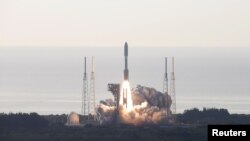The U.S. has launched its next-generation Mars rover in search of potential signs of life on the red planet.
NASA’s latest rover, Perseverance, launched at 11:50 GMT Thursday from Cape Canaveral in the southeastern state of Florida.
The robotic explorer was propelled into space by an Atlas 5 rocket operated by the United Launch Alliance, a joint venture between private aerospace companies Boeing and Lockheed.
The rocket has separated from the first stage and is being boosted to orbit by the Centaur second stage. @NASAPersevere is now preparing for a second burn that will put it on a trajectory towards Mars. #CountdownToMars pic.twitter.com/MBRqcxMTdw
— NASA (@NASA) July 30, 2020
The rover is scheduled to land on Mars in February at the bottom of a 250-meter crater that was a lake some 3.5 billion years ago. Scientists believe the site could hold evidence of possible past microbial life.
Scientists have debated for decades whether there was once life on Mars, which was more hospitable to life billions of years ago.
Perseverance’s landing on the solar system’s second smallest planet will involve a complex set of maneuvers that NASA engineers call the “seven minutes of terror.”
During that period, the rover descends through the atmosphere in extremely hot and high-speed conditions and deploys a set of supersonic parachutes before mini rockets ignite, allowing for a soft landing.
The car-sized Perseverance will also deploy a mini helicopter named Ingenuity and test equipment for future human missions to the planet.
Thursday’s launch from Earth to Mars is the third in July. China and the United Arab Emirates launched probes earlier in the month.
Perseverance is the latest U.S. lander headed to Mars. NASA’s Sojourner landed in 1997 and Spirit and Opportunity have found signs of ancient water formations. NASA also landed Pathfinder, Phoenix and InSight on Earth’s planetary neighbor.
The U.S. plans to send astronauts to Mars sometime in the 2030s. To help pave the way, Perseverance will try to convert elements of the carbon dioxide-rich Martian atmosphere to produce oxygen for future astronauts or to produce fuel for rockets that could be launched from the surface of Mars.








